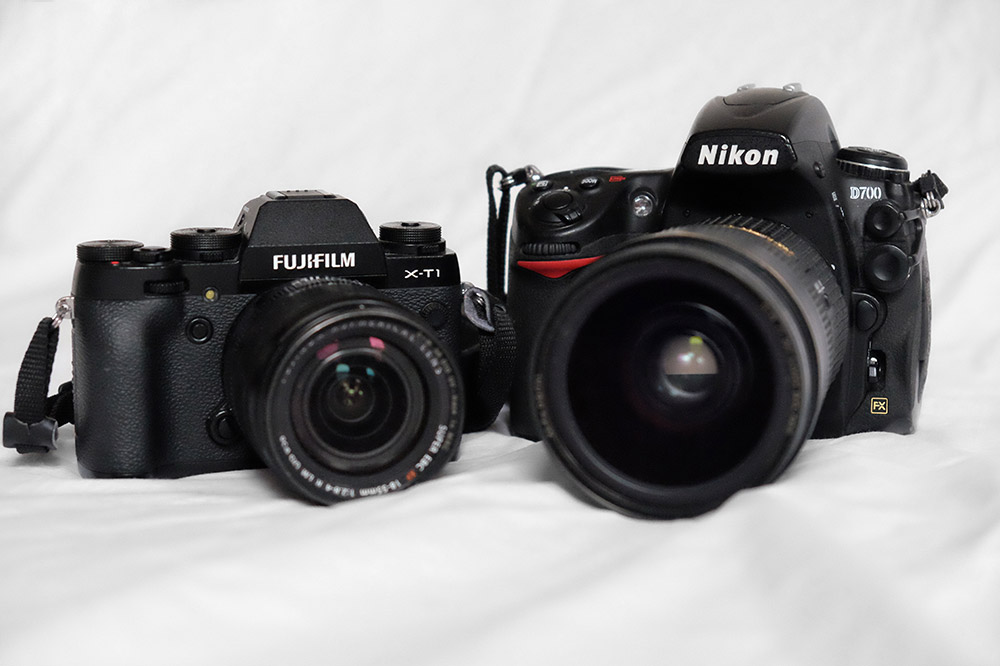Fuji X-T1 and Nikon D700
Firstly, this is not a review, I don’t do them – it’s not even a comparison, I don’t do those either – I’m just musing about what it would be like to use my newly acquired Fuji X-T1 as my daily professional camera. Basically I’m fed up with lugging around a Nikon D700, two heavy lenses and a flashgun and battery pack so I’ve bought the X-T1 with the long term view of replacing all my Nikon gear. It won’t happen just yet – firstly, I need to see what the two f/2.8 16-55 and f/2.8 50-140 zoom lenses are like when they come out later this year and whether they can compete with the speed and quality of the Nikkors I currently own. Don’t get me wrong – I love my Nikon D700 – it’s a real workhorse and has done me proud for quite a few years now, but the shear weight of all this gear can sometimes be a real pain. A days shoot with the D700 coupled with the AF 80-200 f/2.8D ED can really get me down, so I’m hoping I can look after my body a little better with a much lighter set up. I already have a Fuji X pro, which is a great camera and gives some fantastic results but the thought of using it in a professional environment fills me with utter dread – quite simply it just doesn’t focus quick enough – that’s it, everything else is pretty much up to scratch, it’s a great camera for chucking in your bag whilst out and about on your travels but for professional day to day use it just doesn’t cut the mustard, so when I heard the X-T1 has the fastest focussing time in it’s class I was very excited and couldn’t wait to get my hands on one.
Ok, so now I have one and what is it like? Wow is it good! I don’t want to do a Nikon D700 vs Fuji X-T1 comparison, that would be unfair, especially as I don’t have the equivalent lenses yet, but in terms of using it as a daily work camera then yes, I reckon it’ll be up to the job. There are one or two negatives however, so lets get these over with first. Number one is battery life. Compared to the D700 it’s pretty poor, you’ll get around 350 frames with the Fuji compared to several hundred with the D700, but Fuji have been really good and listened to a lot of photographers and have given us the option of using a battery grip which screws on to the bottom of the camera. This also helps with the overall balance of the camera especially when using big lenses. The grip also has shutter release conveniently placed for upright work. The other thing which slightly concerns me is the lack of on-camera flash options. Nikon have a plethora of options and have several powerful flashguns – the SB900 being my favourite as the head swivels pretty much all the way around, which is great for bouncing light off ceilings and walls. At the moment the only TTL option for Fuji X series cameras seems to be the EF-42, which is basically a Sunpak PZ42X. It’s ok, but not as good as the Nikon SB900. Ok, so now for the good bits. The electronic viewfinder is big and bright, and a massive improvement on previous X series cameras and despite it being electronic, it’s easy to forget this as there’s pretty much no lag at all – a real joy to use. The other selling point for me is that all the important controls are beautifully laid out on top of the camera, so no more ratcheting through fiddly menus on screens you can barely understand. All the crucial adjustments can be made quickly and easily. ASA, manual/auto exposure, shutter speed, exposure compensation dial, AE-L and AF-L buttons are all at your fingertips – just how it should be. For the first time in years I can now pretty much use my camera the way I used to, it reminds me of my Contax G2 I had for many years. Fuji haven’t yet reached the holy grail yet but the’ve come pretty close with this one.

